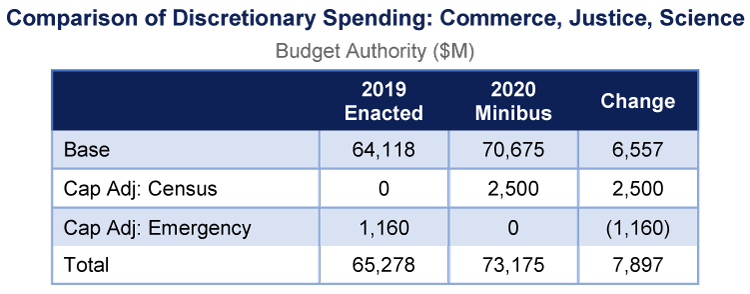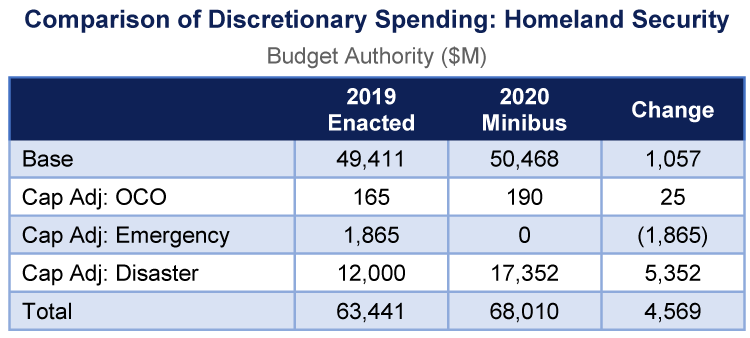House Message on H.R. 1158 – The Consolidated Appropriations Act, 2020
TEWORTHY
Background: The federal government’s new fiscal year began October 1, but the House and Senate have not yet completed action on the 12 annual funding measures. The government is currently operating under a temporary continuing resolution that expires December 20. Without full-year appropriations or a temporary continuing resolution in place by the deadline, the government will shut down.
Floor Situation: The House message to H.R.1158 passed the House on December 17 by a bipartisan vote of 280-138. The Senate will vote on the measure this week. A House message is privileged: the motion to proceed is not debatable, and 60 votes are required to end debate on the measure.
Executive Summary: The text of the House message to H.R.1158 is a four-bill national security-related minibus appropriations bill containing subcommittee appropriations for Defense; Commerce-Justice-Science; Financial Services and General Government; and Homeland Security.
OVERVIEW OF THE ISSUE
The Bipartisan Budget Act of 2019 revised the regular (base) discretionary spending caps established by the Budget Control Act of 2011. For 2020, the revised caps are: $666.5 billion for defense and $621.5 billion for nondefense, an increase of $179 billion over the BCA post-sequester cap levels ($101 billion for defense and $78 billion for nondefense). BBA19 also established guidance for OCO-designated spending in 2020, $71.5 billion for defense and $8.0 billion for nondefense, and created a one-time $2.5 billion cap adjustment for census-designated spending. An agreement established prohibitions against “poison pills,” new policy riders, new ChIMPs, or other changes in policy or conventions that allow for higher spending levels unless agreed to on a bipartisan basis by the four leaders of the House and Senate and with the consent of the president.
H.R.1158 appropriates $767.6 billion in regular (base) discretionary budget authority for 2020. When combined with the discretionary budget authority appropriated by H.R.1865, the domestic and international appropriations minibus, the two measures comply with the revised spending caps in BBA19.
2020 Appropriations Comply with BBA19 Revised Spending Caps

In addition, H.R.1158 provides $92.6 billion in designated cap-adjusted spending for OCO ($70.9 billion), emergencies ($1.8 billion), disaster relief ($17.5 billion), and the 2020 census ($2.5 billion), for a grand total of $860.3 billion in 2020 discretionary budget authority.
NOTABLE BILL PROVISIONS
Division A – Department of Defense
Division A would provide $695.1 billion in total discretionary funding for defense programs in 2020: $622.7 billion in regular (base) discretionary budget authority plus $70.7 billion in OCO-designated funds and $1.8 billion in emergency-designated spending. Overall, this is an increase of $19.5 billion over 2019 enacted levels.

Source: CBO Status of Senate Appropriations for 2019, CBO analysis of H.R.1158
(Total amounts below include base and overseas contingency operations funding)
Pay raise and military personnel
-
$147 billion for military pay.
-
Supports the 3.1% pay raise for troops.
Operations and maintenance
-
$253 billion for operations and maintenance, a $10.8 billion increase over fiscal year 2019.
-
Funds 31 brigade combat teams, five Army security force assistance brigades, and provides for 25 Combat Training Center readiness rotations.
-
$625 million increase in funding for Navy ship depot maintenance.
Procurement
-
$146.0 billion for procurement of weapon systems and other programs.
-
$10.1 billion for 98 F-35 Joint Strike Fighter aircraft.
-
$1.7 billion for 24 F/A-18E/F Hornet aircraft for the Navy.
-
$985 million for eight F-15EX fighter aircraft for the Air Force, with six of these aircraft being funded with procurement appropriations and two aircraft funded with research and development appropriations.
-
$23.9 billion for shipbuilding to fully fund 14 ships.
-
$819 million for remanufacture of 49 AH-64 Apache Block IIIA helicopters.
-
$1.3 billion for the National Guard and Reserve Equipment program.
Research and development
-
$105.2 billion for research and development, an increase of $9 billion above the fiscal year 2019 level.
-
$1.6 billion in medical research for priorities including ALS, breast cancer and other cancers, traumatic brain injury, chronic pain, orthotics, and prosthetics.
Allies and partners
-
$4.2 billion for the Afghanistan Security Forces Fund.
-
$250 million for the Ukraine Security Assistance Initiative.
Transfer authority
-
Provides the Department of Defense with $4 billion in general transfer authority under section 8005, and $2 billion in special transfer authority under section 9002, the same transfer amount available in fiscal year 2019 appropriations for the Pentagon. This is consistent with the Bipartisan Budget Act of 2019.
Disaster funding
-
$1.7 billion for disaster relief efforts related to the consequences of hurricanes, flooding, and earthquakes in 2019. This amount is designated pursuant to the disaster cap adjustment in the Budget Control Act and does not count against the spending caps.
Division B – Commerce, Justice, Science, and Related Agencies
Division B would provide $73.2 billion in total discretionary funding for CJS programs in 2020: $70.7 billion in regular (base) discretionary budget authority plus $2.5 billion in census-designated spending that does not count against the caps. Overall, this is an increase of $7.9 billion over 2019 enacted levels.

Source: CBO Status of Senate Appropriations for 2019, CBO analysis of H.R.1158
The bill prohibits funds from being used to transfer or release detainees held at Guantanamo Bay or to build a domestic facility to house them.
Department of Commerce
-
$15.2 billion for the Department of Commerce.
-
$7.5 billion for the Census Bureau, of which $6.6 is allocated to conducting the 2020 census.
-
Includes a one-time $2.5 billion cap adjustment, as provided in BBA19.
-
$3.4 billion for the U.S. Patent and Trademark Office.
Department of Justice
-
$32.6 billion for the Department of Justice.
-
$9.9 billion for the FBI.
-
$3.3 billion for the U.S. Marshals Service. $1.9 billion is allocated to federal prisoner detention.
-
$2.2 billion for the 94 U.S. Attorneys offices.
-
Provides a $2.6 billion cap on the amount the Justice Department can spend from the Crime Victims Fund for victims and victim’s services. Provides $5.7 billion in budget authority from the CVF (a ChIMP).
-
Provides $2.8 billion for various state, local, and tribal law enforcement grants, including:
-
$547 million for Byrne JAG grants for a variety of state and local law enforcement efforts;
-
$518 million for combatting opioid and other substance abuse addictions;
-
$502 million for grants authorized under the Violence Against Women Act;
-
$320 million for Juvenile Justice grants;
-
$132 million to address longstanding backlogs in testing DNA evidence and rape kits; and
-
$90 million for Second Chance Act grants.
-
Related Agencies
-
Provides $22.6 billion for NASA. Includes funding to support the administration’s plan to return to the moon by 2024.
-
Provides $69 million for the Office of the U.S. Trade Representative.
Division C – Financial Services and General Government
Division C would provide nearly $24 billion in total discretionary funding for FSGG programs in 2020: $23.8 billion in regular (base) discretionary budget authority, plus $151 million in emergency-designated spending. Overall, this is an increase of $465 billion over 2019 enacted levels.

Source: CBO Status of Senate Appropriations for 2019, CBO analysis of H.R.1158
The bill provides for a 3.1% pay raise for federal civilian employees in 2020, which matches a pay raise for military members. The bill also preserves six-day postal delivery.
-
$13 billion for the Treasury Department, $297 more than the 2019 enacted level.
-
$7.4 billion for the federal judiciary.
-
$11.5 billion for the IRS. Prohibitions are placed on using the funds for bonuses and targeting groups or individuals based on their ideological beliefs or for exercising their First Amendment rights.
-
$339 million for the Federal Communications Commission. This amount is offset by regulatory fees.
-
$331 million for the Federal Trade Commission.
Division D – Department of Homeland Security
Division D would provide $68 billion in total discretionary funding for homeland security programs in 2020: $50.5 billion in regular (base) discretionary budget authority, plus $190 million in OCO-designated funds and $17.4 billion in disaster-designated spending. Overall, this is an increase of $4.6 billion over 2019 enacted levels.

Source: CBO Status of Senate Appropriations for 2019, CBO analysis of H.R.1158
Provides $68 billion in discretionary funding for the Department of Homeland Security, including $23 billion for overall border security with funding for physical barriers, immigration enforcement, and border patrol.
Neither this bill, the Defense appropriations bill, nor the Milcon/VA bill contain any new restrictions on the president’s authority to utilize funding from the Department of Defense to construct a border barrier. In 2019, the administration obligated $2.7 billion of non-emergency funding from DOD appropriations toward construction of fencing at the border. The administration also identified and is beginning to obligate $3.6 billion from unobligated military construction projects for the wall. With this funding, the president will have secured more than $10 billion in authorized and appropriated dollars for border wall construction since January 2017.
Customs and Border Protection
-
$14.9 billion overall for Customs and Border Protection.
-
$1.375 billion in fresh funding for additional border wall, not limited to a certain geographic region. Additional border wall is authorized to be built in accordance with the Border Security Improvement Plan.
-
300 border patrol processing coordinators to be hired in order to allow 240 border patrol agents to return to the front lines of the border.
Immigration and Customs Enforcement
-
$8.1 billion in funding for ICE for fiscal year 2020, a $494 million increase over the fiscal year 2019 enacted level of appropriations.
-
42,774 detention beds for illegal immigrants are authorized and funded, with the ability to reprogram funds for more detention beds if needed.
-
Maintains critical transfer authorities to increase detention beds if necessary and sustains investments to combat drug and human trafficking and other transnational criminal activity.
Federal Emergency Management Agency
-
$22.3 billion, of which $17.8 billion is for the Disaster Relief Fund, representing an overall increase of $5.7 billion above the 2019 enacted level. Note: $17.4 billion of DRF funds are designated according to the disaster cap adjustment in the Budget Control Act and do not count against the discretionary spending caps.
ADMINISTRATION POSITION
At the time of publication, a Statement of Administration Policy was not available, but White House advisor Kellyanne Conway said the president is “poised to sign” the legislation.
COST
According to the CBO analysis, H.R.1158 appropriates a grand total of $860.3 billion in budget authority for 2020:
-
$767.6 billion in regular (base) spending: $630.6 billion for defense and $137.0 billion for nondefense;
-
$70.9 billion in OCO-designated defense spending;
-
$17.5 billion in disaster-designated spending (nearly all for the Disaster Relief Fund);
-
$2.5 billion in census-designated spending (pursuant to BBA19); and
-
$1.8 billion in emergency-designated spending (for expenses related to the consequences of natural disasters that occurred in 2019).
